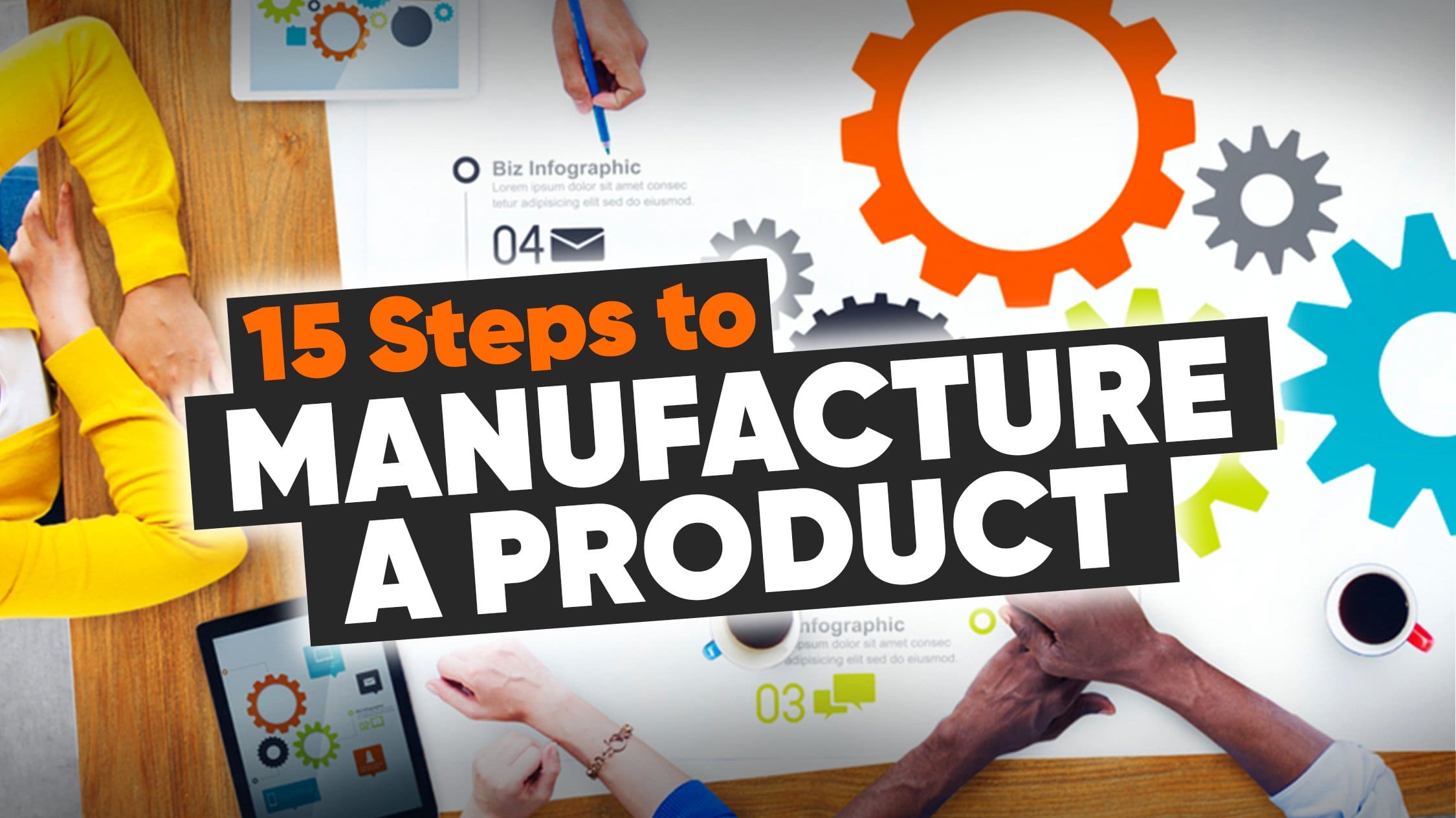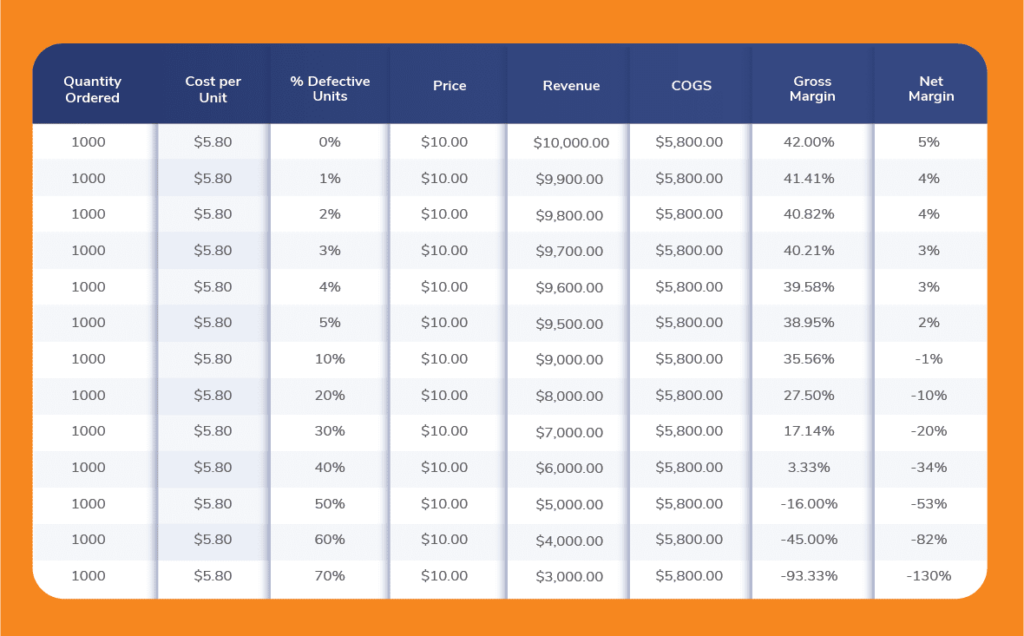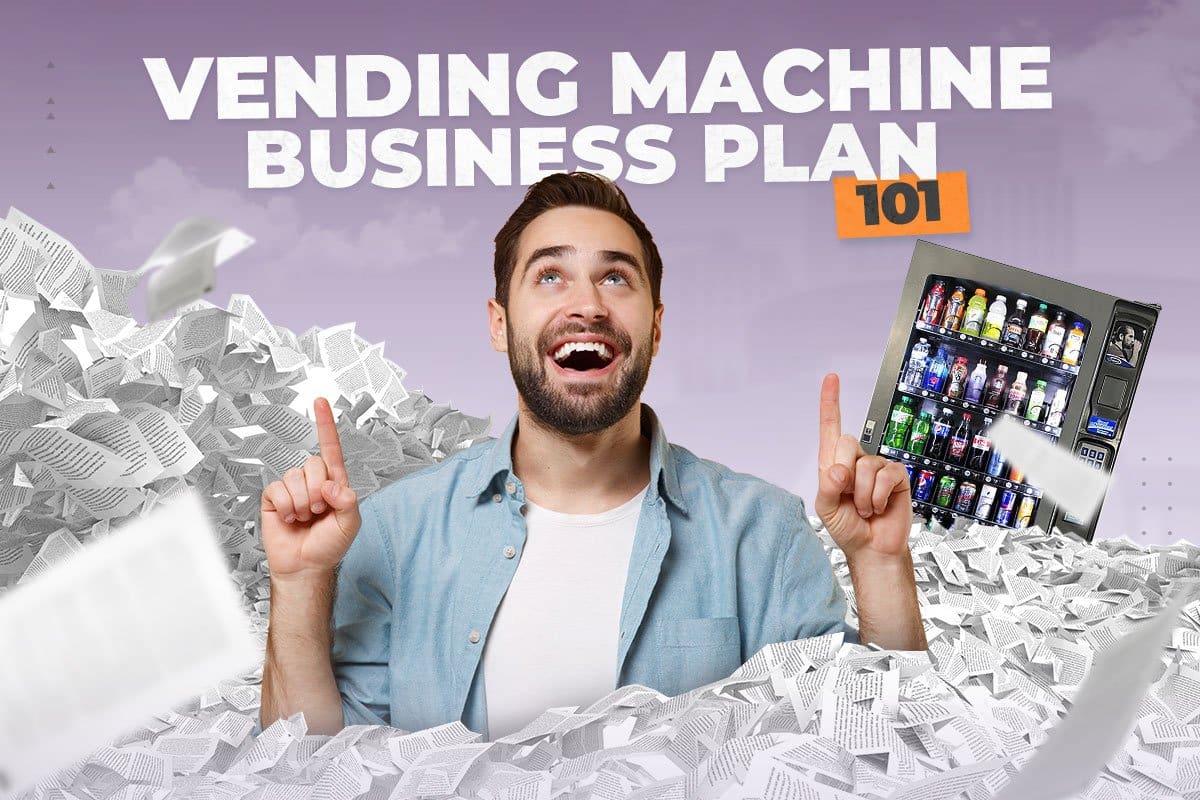You’ve decided to start a business, but your idea is a product that needs to be manufactured. If you have no idea where to begin, that’s completely normal. We’re going to show you how to manufacture a product.
Some of the most successful business owners have created custom products to delight their customers. Pooch Selfie and Shed Defender are two businesses that work with manufacturers and will share how to manufacture a product with us.
We’ll share the manufacturing process and tips so you can learn how each of these petrepreneurs make more than $150K per year. Get ready to learn how to master how to manufacture a product!
How much does it cost to manufacture a product?
Most estimates say you should expect to spend $30,000 to go through the manufacturing process from start to finish, but depending on the products, it can range from as little as $20 for a t-shirt prototype with print on demand, to as much as $400 million for research and development (R&D) and the prototype of SpaceX Falcon 9 rockets.
Step 1. The Idea
You might already have an idea, but there are some things you need to know about product ideas before you go full speed ahead. There are four main things you need to know before you start trying to create your ideas:
- Most manufacturers require a minimum order quantity or amount spent.
- Each product you create will often need to meet the minimum amount for custom manufacturing.
- Raw materials from China only make sense with large quantities.
- The farther you are from a manufacturer, the harder it is to perform quality control and logistics management.
If you have a great idea for 10 different related products, it will be hard to be cost-effective. Choose the best idea and go with it.
Work on the other ideas after you’ve:
- Found the right manufacturer
- Mastered the process from design to manufacturing
- Successfully sold the finished product
If you don’t already have an idea, that’s okay because they are all around you. Listen to things your friends and family say they wish someone would create. If someone hasn’t already, you’ve found an opportunity.
Casey Walter, the owner of Shed Defender, told us:
I came up with the idea of a doggie onesie because I got tired of my friends complaining about my Saint Bernard shedding. People used to laugh at me when I created a onesie for a dog, but it didn’t stop me.
Check out his interview below:
Jason Hernandez, the owner of Pooch Selfie, had a similar path to his idea. He told us:
This was really a backyard invention that I created because my dog, Logan, won’t sit still when we’re trying to take a picture of him. He loves tennis balls, but not the camera. Let’s see what happens if we put the two together.
Keep reading for the next step of manufacturing high-quality products.
Step 2. Design or Sketch the Product Idea.
You can’t start the production process until you create a design or sketch of the product. No one can see what is in your mind’s eye. You have to give them something to help them understand what you need.
If you have graphic design experience, use it to design the product. You can use products like AutoDesk products if you have them already but read about the best product design software before you go spend $355 per month on AutoDesk software.
It’s okay if you don’t feel like you are a great artist, you don’t have to be. This is just to help a local artisan understand your intent. Give it your best and make sure you document the date of the idea to protect yourself if you talk to anyone about it.
You can document an idea’s date through several methods:
- Metadata of digital files: Enables experts to track the date of the original idea
- Include it on a physical drawing: Put a date on the drawing, then take a picture, and immediately email it to yourself.
- Get it notarized: This is going a bit far, but if it’s that valuable it might be worth it to have a notary witness you sign and date the document.
Step 3. Find A Product Development Consultant
Once you have an idea and drawings, you might need to approach someone who knows how to manufacture a product and has done it many times before. They can help you reduce the time to complete the rest of the steps.
You can hire professional consultants or just talk to business owners you know. As long as they are in the same industry, they’ll be able to give you some advice about how to make a product.
Before you talk to them, you’ll need to have them sign some documents to protect your idea. Let’s dig deeper to protect your idea before you have filed for intellectual property protection.
Business documents to protect your idea

Businesses are notorious for using others’ ideas to make more money. Whether they do it legally or illegally, doesn’t matter. If you want to protect your company idea make sure you have people sign these documents before sharing business information:
You’ll want to have the following documents signed before you provide any information to other people:
- Non-Disclosure Agreement: This is to protect against people disclosing information about any confidential information.
- Non-Compete Agreement: This is to protect against a person or company using information they gain to create their own product.
- Exclusivity Agreement: This is to prevent a company from using your equipment. UpCounsel (not related) has a good breakdown of what should be included.
Now you know how to protect yourself and your small business against bad actors. Let’s look at sourcing materials for a prototype.
Step 4. Source Materials for the Prototype
The next step in product manufacturing is sourcing the materials for a prototype. You’ll normally want to look for a supplier of raw materials that will sell in small quantities. Places I would recommend looking include:
- Local craft stores
- Amazon
- Walmart
- Places that own 3D printers
- Machine shops
- Recycling yards
The goal here is to get the raw materials quickly and at the lowest dollar amount. Small businesses don’t need a large upfront investment for something the target market might reject.
Finding suppliers should not extend internationally right now unless you can not find another way in the United States. International shipping can end up costing 10x the value of the small amount you need to start producing prototypes.
I had a client that ignored my suggestion to stay local and ended up spending $1,200 for a roll of fabric for his eCommerce business that he could have bought locally for $70. Ninety-nine percent of it was shipping costs.
Do you find that hard to believe? Read this blog about shipping costs from China to understand how something like that happens. You can complete the entire process of starting an eCommerce Print-on-Demand store for the same price as shipping from China.
Once you have the parts for a prototype, it’s time to create your original design. Keep reading to find out how.
Step 5. Create the Prototype

Creating a prototype to show your target market, the United States Trademark and Patent Office, and potential manufacturing partners, will be necessary to limit the risks and improve the chance of success.
There are several ways you can make a prototype depending on the type of product. The most common are:
- Self-produce
- Work with a print shop
- Work with a local seamstress
- Work with craftspeople
- Hire a manufacturer who manufactures prototypes
As a new business owner you may not have the skills, resources, or equipment to create a prototype in-house, but if you do, it is a great way to establish the production process so you can specify it when looking for bulk manufacturers.
Once you’ve completed the prototype, there are a few steps you can work in parallel to speed up the process.
Perform in Parallel
You’re heading in the right direction! Now is when the most challenging parts come into play. Fortunately, you can perform the next five steps in parallel. Before you can start mass-producing products, you’ll need to:
- Test the Prototype
- Apply for Patents and Trademarks
- Create Cutsheet or Manufacturer Specifications
- Find and Purchase Bulk Materials
- Find Quality Manufacturers
We’ll walk you through each of the steps to help you learn how to create a product.

Step 6. Test the Prototype
Once the prototype is created, you’ll want to verify that it works properly and that there is an actual demand for it. Use the item to see if you like it because your views of the product can influence success.
After you test it, start performing market research. Market research can be as simple as letting friends and family test it or conducting formal research using a market research firm. Just search “market research company near me” to find ones to work with locally.
Questions to ask will be different for each product, but let’s look at some that Pooch Selfie might have asked:
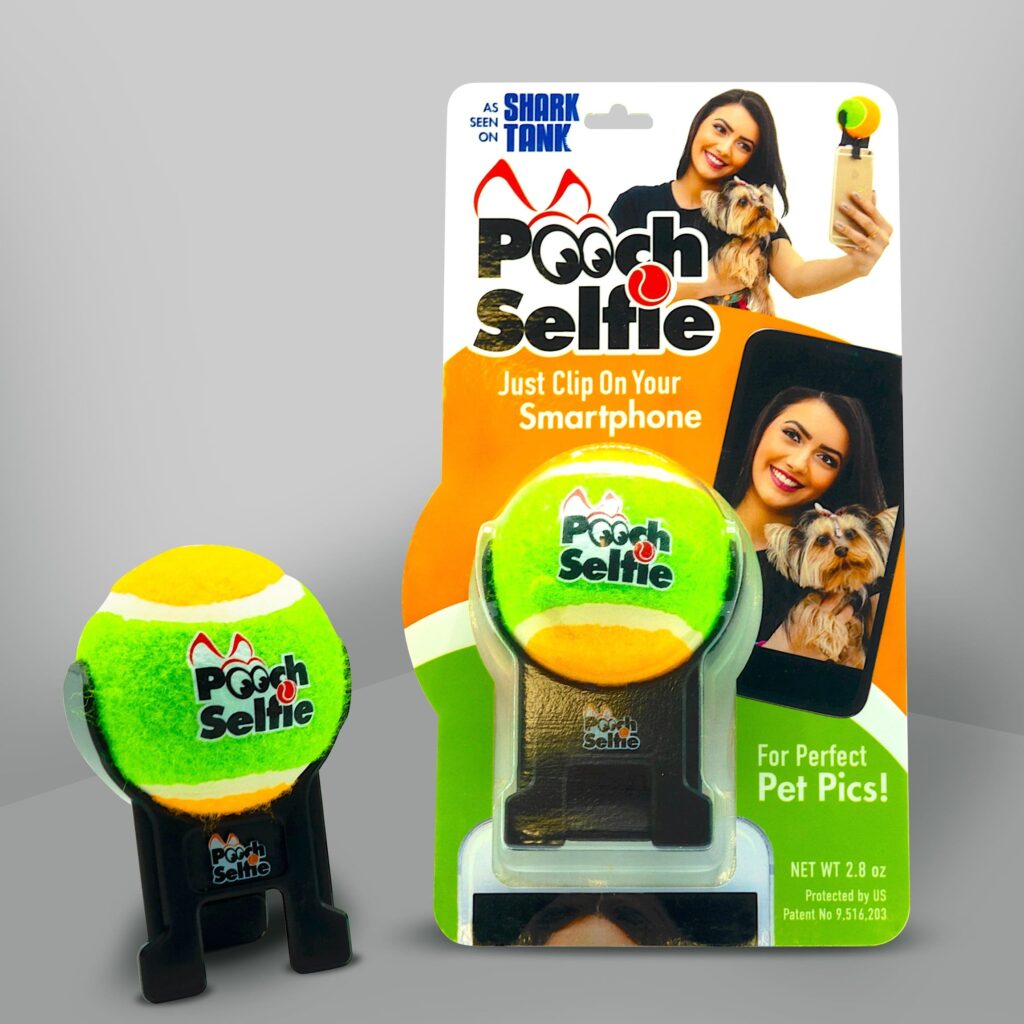
- Do you have difficulty getting your dog to stay still for pictures?
- Does your dog like tennis balls? If not, what do you think they’d like more?
- How often do you think you’d use this product?
- If you saw this product in stores, how much would you expect to pay?
- How many tennis balls would you want to come with the product?
- Where would you expect to see this product?
Check out our interview with Pooch Selfie below!
The goal is to determine the target audience, how to best sell the product, and whether the product solves the problem. While you (or a market research firm) are working on the market research, you can also work on applying for trademarks and patents.
Step 7. Apply for Trademarks and Patents
Trademarks and patents are to protect intellectual property(IP). Trademarks protect brand names, logos, and slogans that you don’t want other companies to use. Patents protect inventions based on whether it meets the following requirements:
- Does it fall into the following categories of products?
- Machines
- Processes
- Articles of Manufacture
- Compositions of matter
- Is it unique? More specifically, is there a similar type of product already on the market?
- Is it useful?
- Is it obvious? If it is obvious it cannot be patented, so make it a point to prove it is not obvious. Remember, once something has been created, it is obvious why it makes sense.
You’ll want to get protection in the countries you are selling and manufacturing the products. In the United States, apply for trademarks and patents at USPTO.gov. For international IP protection, go to WIPO.int.
Now that you know where to patent and trademark your item, let’s look at creating manufacturer specifications.
Step 8. Create a Cutsheet (Manufacturer Specifications)
When wondering how to get a product manufactured, you’ll need to create manufacturer specifications. These are often called “cut sheets” or “tech packs” and are used in most industries. See the picture below for an example of what a cut sheet for a clothing manufacturer might look like.
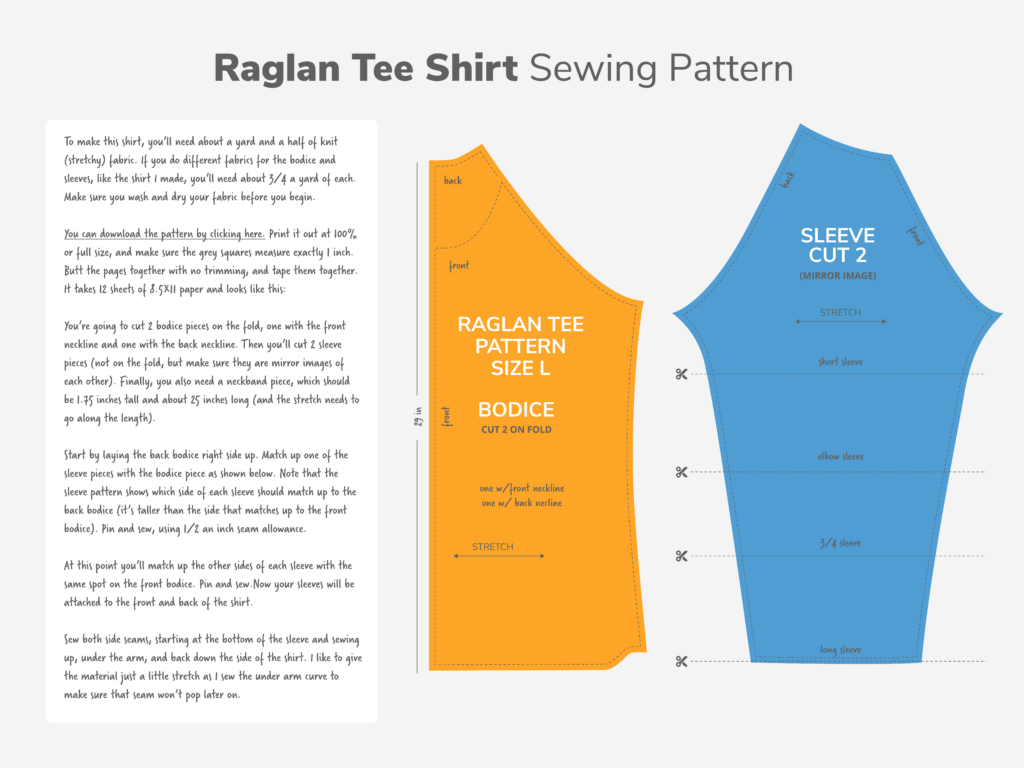
Shed Defender would use something similar, but with specifications for different dog sizes, meaning in addition to the neck, armholes (front leg holes for dogs), chest, and waist, they’d need rear leg holes, tail hole, and measurements so the garment allows the dog to tend to its needs.
This document should include:
- Identifying Information: Business name, product name, model number, style number
- Date: Show when the tech pack was created. Helps protect and defend theft of IP
- A picture: Help manufacturers and suppliers see what it looks like
- Measurements: All measurements necessary to properly manufacture the product for each size of the product
- Colors: Use the form #000000 (black) to #ffffff (white). Identify colors at color-hex.com. Create a different sheet for each variation of colors for materials.
- Product care information: The tags on clothes should follow specifications outlined in coats.com’s product care standards blog.
- Technical information: Volts, watts, amps, anything needed for it to run properly
- Materials: Type of material, description of the material, color, quantity, supplier
- Notes: Any notes needed to help the manufacturing company create the product
I figure you might want to know about other industries, too. For example, here is another example from a plenum kit used in HVAC equipment.
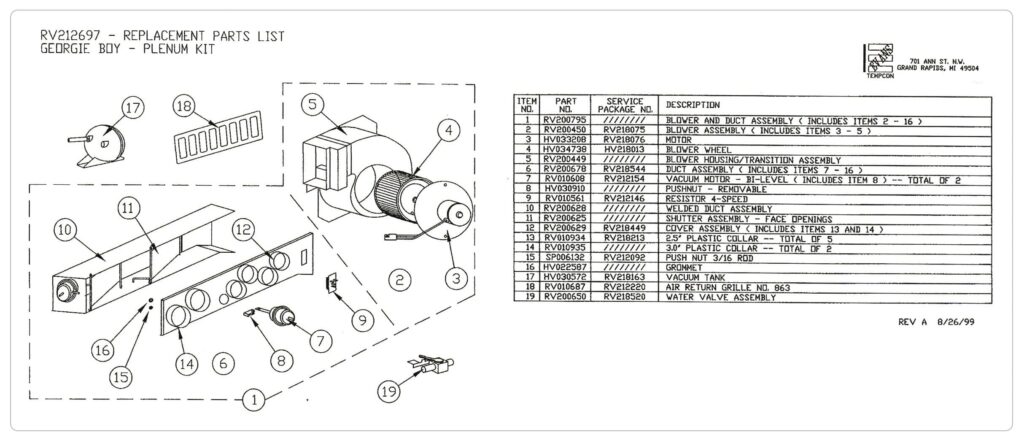
Once you have this, it’s time to find a supplier and manufacturer.
Brief interlude to explain shipping’s impact on the process
Before we provide a list of references, it’s important to remember that the shipping costs from China should be assumed to run $1,200 or more and take months to get here. Commerce.gov estimates that you should expect:
- Documentation, customs clearance, handling, and inland shipping: 17-33 days
- Time shipping from overseas to US: 14-30 days (sustainable solutions up to 120 days)
- Shipping time once in US: 6 days
- Total time in shipping: 37-69 days
If this occurs multiple times, you might have a real issue with turnaround time. Turnaround time is the time from when you order something to when you receive it. Let’s show how this can play out when manufacturing products:
- Order fabric from China and ship to US: 69 Days and $1,200+
- Review fabric order to verify it is correct: 3 days
- Ship to manufacturer in Cambodia: 69 days and $1,200+
- Manufacturing time: 30 days
- Ship to a distribution center: 69 days and $1,200+
If it plays out this way, every order will take nearly nine months to produce and cost at least $3,600 in shipping. That is far too long for a small business owner.
In a best-case scenario, you might reduce the time to 67 days and $1,200 in shipping if the supplier and manufacturer are in the same overseas location. You’ll need to have efficient quality control processes though.
You also need to consider how this impacts costs associated with inventory and gross margin. Ready Ratios has industry gross margin ratios by year, but most are between 20-55%.
The formula is:
Material costs + cost of manufacturing + all shipping + labor attributable to sales
= 45-80% of expected revenue.
To justify $3,600 in shipping costs, you’ll need to make at least $100K in revenue.
Run your decision-making through a sanity check before going with overseas manufacturers and suppliers. Financial issues are the #1 reason small businesses fail. Keep that in mind, and start by looking for manufacturing partners in the following order:
- Locally-owned manufacturer and supplier
- Regional manufacturing partners
- National manufacturing partner and supplier
- Overseas manufacturers and supplies
Now that we’ve covered this product manufacturing process example, let’s discuss suppliers.
Step 9. Research Bulk Materials and Find a Supplier
You’ll need to find a supplier to provide any materials you need to manufacture the products. Depending on the type of products, you might need raw metals, raw cotton or fabric rolls, plastics, zippers, buttons, or other products.
It can be hard to find suppliers if you’ve never looked for them before, so we’ve provided a list of places to find suppliers:
- Thomasnet: Search for suppliers by product or service, brand name, or company Name. You can also browse by industry, find buyers, and get industry insights from them.
- IndustryNet: Request a quote online and get quotes from all qualified companies by filling out their short form:
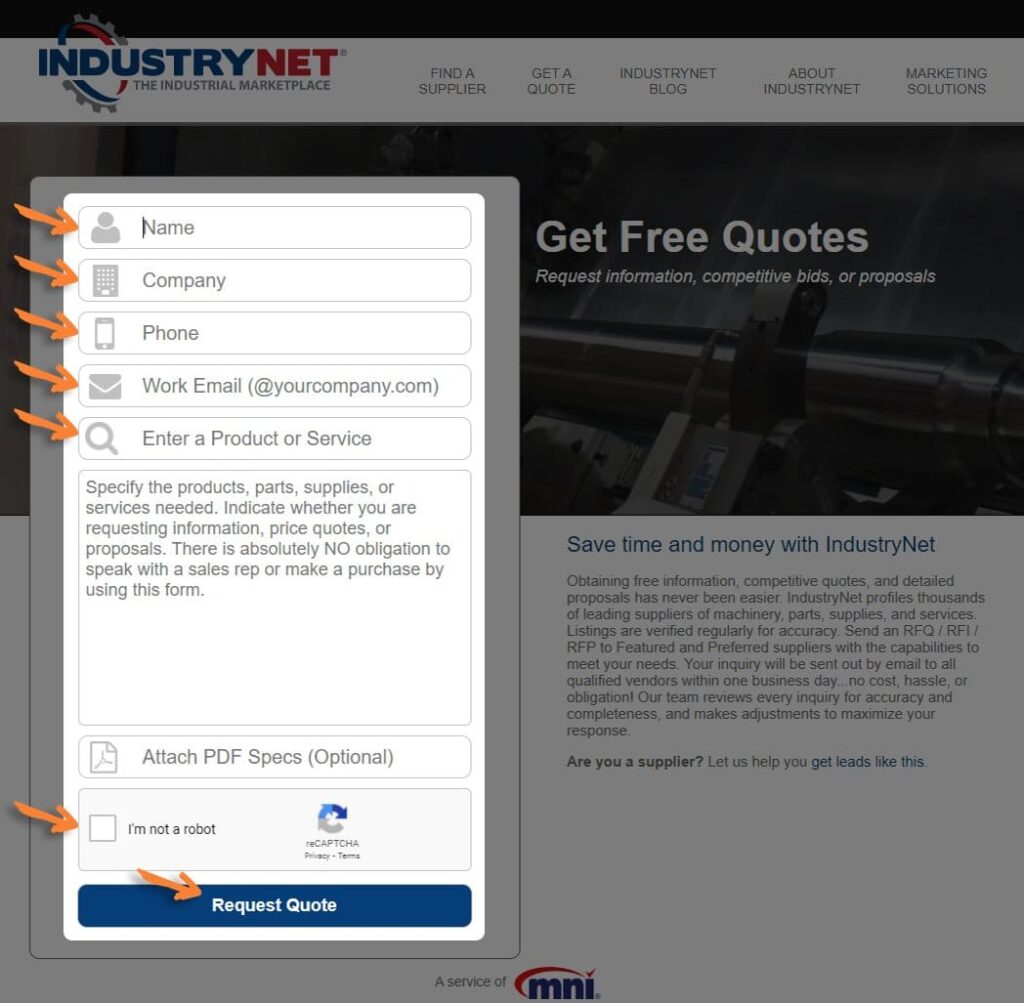
- Global Sourcing Specialists: If you want someone to help you with the whole process, I’d start out by contacting GSS. They will help you with sourcing, manufacturing, and quality control. This is more of a consulting company, but worth the mention.
- Maker’s Row: Costs $60-$150 a month, plus an additional 10% for each seat on team accounts. Maker’s row connects customers with more than 10,000 manufacturers and suppliers. I’d try free sites first, but this site appears to be related to the MAGIC tradeshow (see next bullet point for more info on the show).
- MAGIC Fashion Events: There are five events every year that include a trade show. Manufacturing companies and fabric suppliers go to Las Vegas, New York City, and Nashville to show off their newest fabrics, manufacturing equipment, and have a blast. I went for a client several years ago. It stimulated my creative juices.
You can also search Alibaba’s Gold Supplier list for suppliers who pay extra to be certified by Alibaba. As a Gold Supplier, you know they are a legitimate business that has been verified and inspected by a third party.
Be aware that shipping goods from China can take 37-69 Days normally and up to 6 months for sustainable travel.
Step 10. How to Find a Manufacturing Company to Manufacture Your Product
The links in the supplier section also help people find manufacturers. This section is going to focus on establishing what qualities make great manufacturers. We’ll look at how to find manufacturers in China and the US.
How to manufacture a product in USA
Start locally to reduce shipping costs, time zone barriers, and quality control challenges that people face when looking for manufacturers. Just search “manufacturer near me” or “Apparel manufacturers near me” to find the ones closest to you. Hopefully, you’ll find a few local manufacturers.
Read the reviews or search for the local manufacturers on the manufacturing sites we listed. Reach out to find out about their limits on small batches, quality control standards, and if you can tour the facility. If they don’t meet your needs, find a manufacturer that will.
Finding a manufacturer in the USA has gotten easier in the last few years because technology and supply chain issues are reducing the competitive advantage of overseas manufacturers. The cost to produce manufactured goods is often competitive when comparing the total cost.
You don’t need the absolute best price because when you manufacture products you need to balance:
- Price
- Ability to scale from small batches to mass production
- Speed of delivery
- Deviation from the standard of manufacturer goods
Send your specifications to several manufacturers to establish which one will be the best one for you. Hopefully, you’ll have multiple manufacturers to choose from, but when first starting, you may be limited to a single local manufacturer because most have minimum quantity orders.
Now that you’ve found some potential manufacturers locally, it’s time to reach out to a few manufacturers overseas.
How to find overseas manufacturers
Follow the same process as you did for finding local manufacturers, but now you’ll be focused on how to find a company to manufacture your product overseas. Ecommerce entrepreneurs will be able to find more than one manufacturer overseas, but they need to be wary of several challenges:
- Trading companies: They might pose as a manufacturer, but a trading company can not actually manufacture goods.
- Working conditions: An overseas manufacturer may have working conditions that your target frowns upon. When considering how to manufacture a product in China, you may not want to pay kids working on factory floors. That could become a PR nightmare.
- Manufacturer company time zone: Working with a manufacturer that is on the other side of the planet can complicate business communication. If you aren’t down for 11:00 PM meetings, look for other manufacturers.
- Costly to visit the manufacturer: While visiting a shop supplier and manufacturing company overseas is something you should do, it becomes much more costly than driving to the nearest manufacturing hub in the U.S.
Keep these things in mind when considering how to approach a manufacturer with your product idea. Most will provide a quote through email, but that doesn’t show what goes on in the factory.
After you have received bids from multiple overseas and local manufacturers, it’s time to compare the costs.
Step 11. Compare Manufacturing Costs
You found a few different potential suppliers and manufacturing facilities, visited them, and got quotes. Now it’s time to compare them. I tend to like using a multi-factor ranking system to compare competitors. I like using the following system in an excel spreadsheet:
- Name: First column
- Location: Second column. Use city or country
- Price: Third column. Use quotes. Lowest = highest score
- Distance to nearest Supplier: Fourth column. Use Google Maps. Lowest = highest score
- DIstance to me: Fifth column. Use Google maps. Lowest = highest score
- Quality Control: Sixth column. In my example, I ranked them based on engineering experience combined with my ability to be there to establish if they are up to my standard. Best = highest score
- Rank them: Best gets the highest scores in each column, then use the function =SUM (C10:E10) in cell G10, and then approve the autofill to get the totals.
You will get something similar to the picture below.
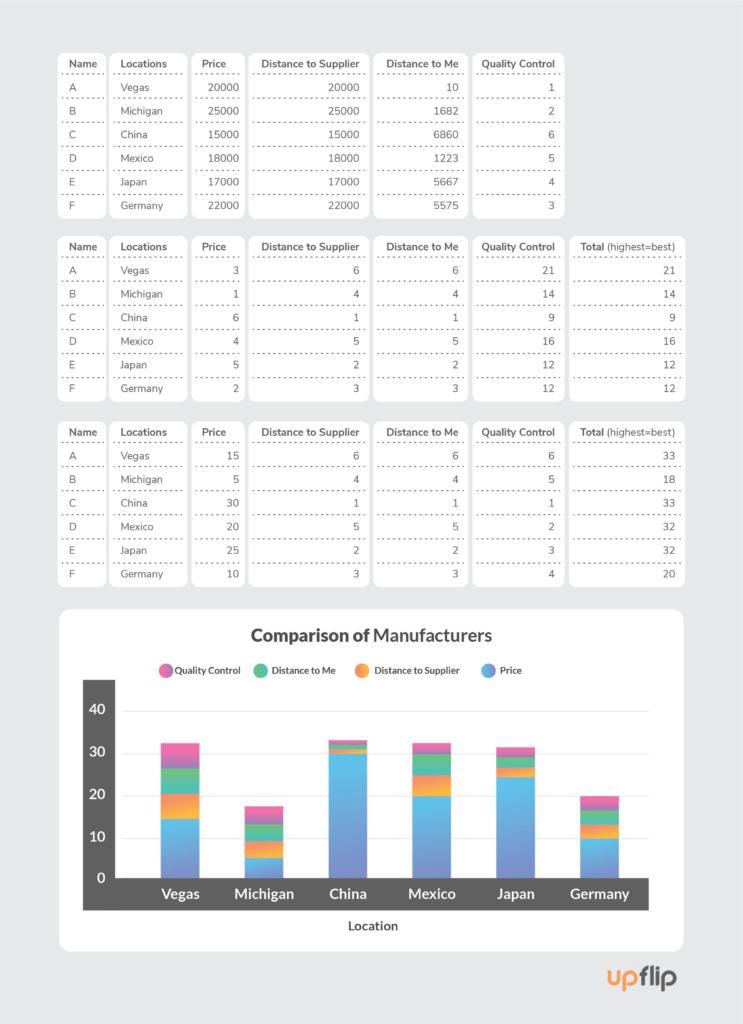
If you want to assign extra weight to each aspect you can but it took including a 5x multiplier on the price columns ranking for me to shift the favor to China in this example. You can see below that the change made China tied with Las Vegasfor the most favorable option.
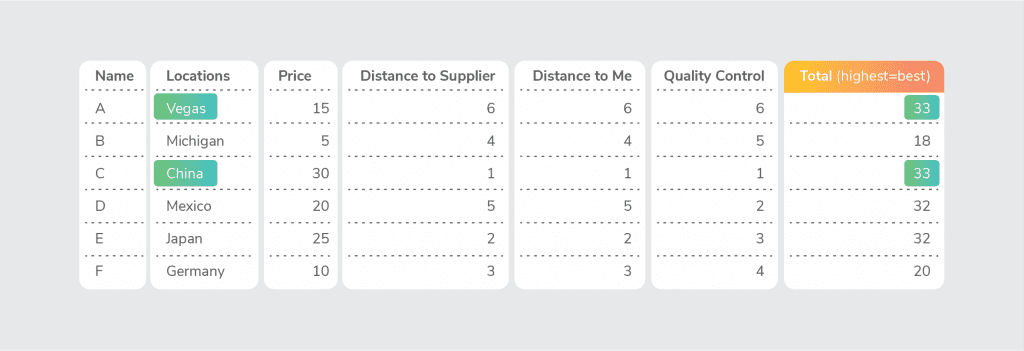
I hope this has helped you understand why I would tend to gravitate towards manufacturing near me during the early stages of product manufacturing.
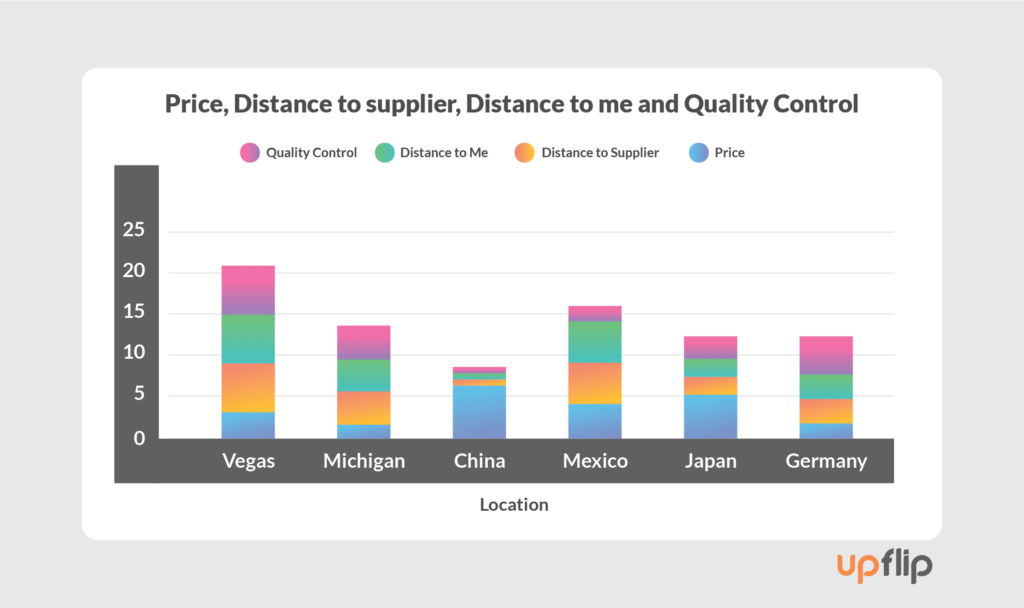
Step 12. Most Manufacturers Will Negotiate
When you are negotiating manufacturing contracts, the intent is to have long-term relationships that are mutually beneficial. We strongly recommend you consult with an experienced contract attorney before negotiating the terms of a manufacturing contract. These are the most common terms to negotiate:
- Price: How much you pay per unit. Price tends to function inversely to how favorable the other terms are for you.
- Duration: Length of contract. Longer lengths can impact price and exclusivity terms.
- Quantity: Buy more for higher discounts.
- Exclusivity: Terms that benefit the manufacturer or brand owner.
- Manufacturer: The brand owner agrees to solely use the manufacturer.
- Brand Owner: The manufacturer agrees not to manufacture competitive projects
- Often both will be employed to help protect each side’s interests.
- Example: Pooch Selfie might have a contract where they agree to work with a manufacturer for five years, but the manufacturer cannot sell the design to Shed Defender or other pet product brands for the same five years.
- Frequency of Orders: How often do you agree to receive orders
- Shipping: Who covers what shipping costs. Often the manufacturer covers shipping in their country and the brand owner covers it once it departs the port in the manufacturer’s location.
- Payment Terms: What portion are you paying?
- Upfront
- Upon Completion
- Upon Delivery
- Upon Sale: If you want a net-30 you need to let them know at first contact.
- Cancellation Terms: What is considered a violation of the contract? And what are the penalties?
Once the terms are negotiated, it’s time to produce the goods with either a local or overseas manufacturer. It’s normally better to start with smaller batches to minimize the risk of custom manufacturing. This may not be possible with all manufacturing partners depending on their minimum order size.
Step 13. Begin Manufacturing
This stage will be handled by an overseas or local manufacturer. If you are personally overseeing adherence to the contract, you’ll need to periodically check in to verify that the specifications are met and the timeline is still achievable.
Step 14. Manage Logistics and Quality Control
Once the manufacturing process is complete, the goods will be shipped. You can save some money by picking them up if you are using a local manufacturer, but be prepared to work with customs if using an overseas manufacturing partner.
Go to the US Customs and Border Protection (CBP) website to review the CBP importing goods guidance. They are the governing authority for importing and exporting. The U.S. Economic Development Administration also has resources to help businesses.
Once you receive the goods, you need to inspect every piece and verify that each one meets the specifications. Hopefully, your contract had effective risk management strategies included in it, all parties followed them, and any defects were caught earlier in the process, but you should still check.
Reject any faulty products because every faulty product you accept raises the cost of goods sold. You can’t afford to accept faulty products. Using fairly normal eCommerce margins, you’ll be losing money when you sell on your own website at around a 10% defective rate. If you sell online using other platforms, losses will occur much quicker.
Step 15. Packaging
Before a product is truly ready to sell, you’ll need to provide packaging. Whether you use branded packaging or generic packaging is highly dependent on what type of product and brand you are trying to create. You can either use custom packaging or generic packaging. Let’s look at each.
How to Create Custom Packaging
You can go with custom packaging, in which case you’ll need to hire a graphic designer on a site like Fiverr or Upwork. Make sure you find someone with experience in product packaging. Then, follow the same process outlined in this blog to have it manufactured.
ThomasNet has a great list of custom packaging manufacturers. Find one that works for you.
How to Find Generic Product Packaging
If you are looking for generic packaging or companies that allow you to design it yourself, check out Packlane, which has a TrustPilot Score of 4.8 over 355 reviews.
You can also find clear baggies and other generic products on most marketplaces. For instance, Amazon has a pack of 100 9”x12” cellophane for t-shirts for $9.99
Wrapping It All Up
This step-by-step guide on how to find a manufacturer and create a product has provided you with the information you need to create your own product.
If you’d rather focus on finding customers, Amazon helps people create their own books, t-shirts, and phone cases, while FastCap pays royalties for product ideas related to the construction industry.
Which parts of the manufacturing process would you like to learn more about in future content?

